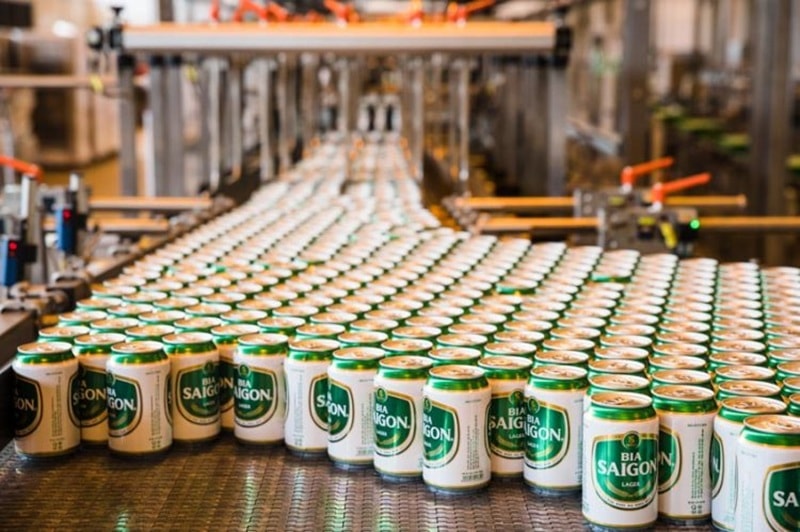Is Sabeco’s dividend still attractive?
Facing growth challenges, Saigon Beer – Alcohol – Beverage Corporation (Sabeco, HSX: SAB) has adopted a strategy focused on cost optimization and maintaining an attractive dividend payout to draw investor interest.

At the end of July, Sabeco is expected to pay a 30% cash dividend. This stands out as a positive signal to investors amid a still-challenging outlook for the beer industry.
A “Trough” in Business Performance
In the first half of 2025, Sabeco has been grappling with both internal difficulties and policy headwinds. While the company has yet to release Q2 results, Q1 figures already reflect a significant drop in revenue and profit. Specifically, by the end of Q1/2025, Sabeco reported net sales of VND 5,811 billion, down 19%, and net profit of VND 793 billion, down 20% year-over-year.
Several factors contributed to this decline. First, the beer consumption cycle was affected by the early arrival of the 2025 Lunar New Year, which shifted demand into Q4/2024, making Q1/2025 seasonally weaker — a timing issue largely beyond Sabeco’s control. Second, Decree 168/2024/ND-CP, effective January 1, 2025, imposes stricter penalties for alcohol-level violations when driving, severely impacting on-trade sales — Sabeco’s core channel.
In fact, Sabeco has been attempting to adapt to regulatory risks since the issuance of Decree 100/2019/ND-CP, by developing non-alcoholic beverages. However, consumer behavior toward these alternatives has not yet grown strong enough to offset declines in traditional beer consumption.
Additionally, Sabeco reported a sudden financial expense of VND 91 billion stemming from the acquisition of a larger stake in Sabibeco — raising ownership from 21.8% to 65%, which increased its short-term financial burden.
Based on Q1/2025 results and market developments into Q2, analysts at VDSC believe Sabeco and its industry peers still face lingering difficulties. For Q2/2025, Sabeco’s net revenue is estimated at VND 7,116 billion, down 12%, and net profit is projected at VND 1,112 billion, down 10.9% year-over-year.
The main reasons include a summer period lacking major events and continued pressure from Decree 168/2024, which constrains traditional consumption channels. Nevertheless, Sabeco is expected to recover strongly quarter-over-quarter, thanks to the low base in Q1 and a more aggressive distributor discounting strategy to reclaim market share from Heineken.
Looking further ahead, the outlook for Vietnam’s beer industry remains uncertain. Decree 168/2024 follows Decree 100/2019 in erecting consumption barriers, particularly for on-trade channels — which contribute a major portion of sales. Compounding this is the Special Consumption Tax hike approved by the National Assembly in June 2025, which will raise beer tax rates from 65% to 90% over 2027–2031. Additionally, with per capita beer consumption in Vietnam exceeding 60 liters/year, regulators are inclined to further tighten controls.
Given this context, Sabeco’s medium- to long-term revenue growth potential appears limited. For 2025, its net revenue is projected to reach VND 26,965 billion, down 15.4%, with net profit forecast at VND 3,814 billion, down 11.9% from 2024.
Adaptation Strategy
In response to growth headwinds, Sabeco has secured lower input prices, particularly for malt. The depletion of high-cost raw material inventories from Q1 is seen as a bright spot, allowing the company to improve margins using cheaper inputs.
Sabeco continues to promote sales through the off-trade channel — which saves on marketing, operations, and logistics. It is also cutting spending on advertising, personnel, and promotions in bars and restaurants. However, while cost-cutting helps, it may also backfire by losing market share to competitors.
Thus, 2025 is expected to remain a challenging period for Sabeco and Vietnam’s beer sector as a whole.
Despite declining earnings, SAB shares continue to attract investors due to Sabeco’s commitment to maintain a cash dividend of VND 5,000/share for at least two years (2025–2026), translating to a dividend yield of around 10.4% — highly appealing in a volatile market. Prioritizing dividends also aligns with the strategy of ThaiBev — Sabeco’s controlling shareholder — aiming to maximize cash flow back to the parent company to service the loan taken to acquire Sabeco in 2017.
In the upcoming payout, with nearly 1.3 billion outstanding shares, Sabeco plans to distribute over VND 3,900 billion. Thai shareholders, holding 53.59%, will receive over VND 2,100 billion, while SCIC, owning 36%, will pocket around VND 1,400 billion. Earlier, in late January 2025, Sabeco had already made an interim cash dividend payment of 20% for the first round of 2024. With this second payout, the total dividend for 2024 reaches 50%.
With a 2025 forward P/E of 16.2x, Sabeco’s target valuation is VND 54,100/share including cash dividends, according to VDSC. Compared to the July 20, 2025 closing price of VND 48,050/share, the expected return is about 12.6%. However, since Sabeco finalized its list of shareholders for the dividend in early July and already distributed the first round, the net expected return from price appreciation alone is just about 6.35%.
Therefore, SAB shares are best suited for dividend-seeking investors who value steady income and enter during price corrections with lower valuations — rather than those betting on short-term growth momentum.








